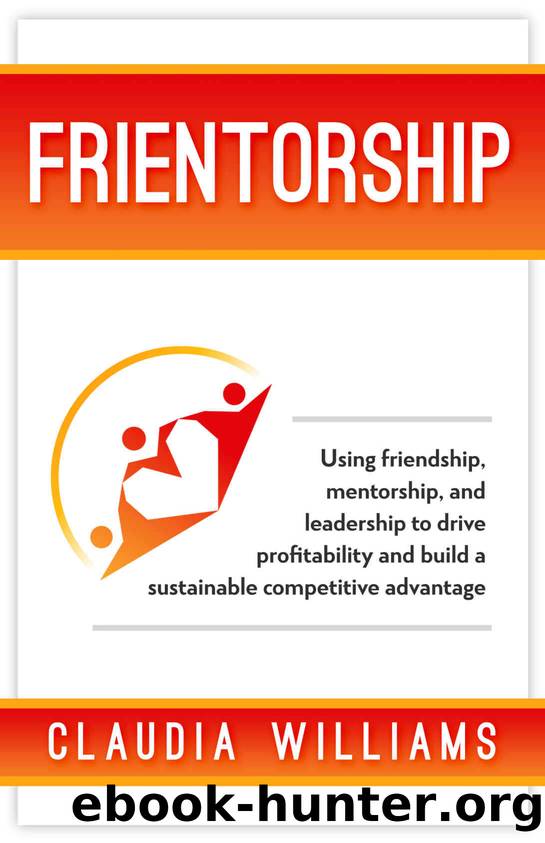Frientorship: Using friendship, mentorship, and leadership to drive profitability and build a sustainable competitive advantage by Williams Claudia

Author:Williams, Claudia [Williams, Claudia]
Language: eng
Format: epub
Publisher: Year of the Book
Published: 2018-03-13T00:00:00+00:00
Frientorship Facts
⦠Mentorship is a relationship built on trust and respect with an advisor, counselor, and coach.
⦠It is our responsibility to take charge of our career development. Mentorship is a way to both foster meaningful connections and increase our skills.
⦠Mentorships are two-way streets. Always be willing to offer to help your mentor. Chances are, you have strengths that can benefit your mentor.
Chapter 7
The Benefits of Great Mentorships
Tell me and I forget. Teach me and I may remember. Involve me and I learn.
~ Benjamin Franklin
T he first and most obvious benefit of mentorship is that we develop skills that we once lacked. There are so many benefits to mentorship that go beyond skill development for mentees, and those benefits extend to mentors, employers, customers, and clients.
A lot of companies are very good at attracting great people. They can tell a wonderful story and have rockstar employees participate in the recruiting process and paint an overall picture of a company that would make anyone want to get on that train. Many companies fall short when it comes to retention, though. Itâs almost as if they check the box when they fill a vacancy and move on to the next one without putting substantial effort into retention.
Employee turnover comes with a high cost to the company, bringing with it both direct and indirect costs. The obvious ones are the dollars that follow an employee out the door. Those costs include advertising, time spent by employees reviewing résumés and conducting interviews, travel costs for applicants, hiring bonuses, relocation costs, training costs, uniforms, drug testing and other post-offer, pre-employment screenings. It adds up quickly.
Then thereâs the work that isnât getting done by the employee who walked out the door. âOh we donât have that problem,â says XYZ Corporation, âbecause we take that work and spread it around to the other employees in the department until the vacancy is filled.â That might work for a week or two or maybe even a month, but chances are the vacancies arenât filled that quickly. Employees who are already at capacity because of their own jobs are now being asked to take on more work (without more pay, by the way). Any way you slice it, work is not getting done. When work isnât getting done, a client or customerâs needs are not being met. Period.
The other hidden costs associated with high turnover include lost productivity because of time spent complaining by employees who are picking up the slack. You might not be able to measure employee frustration on a day-to-day basis, but those costs add up, and their frustration is legitimate. High turnover has a direct impact on morale. Morale has a direct impact on productivity.
Sometimes an emergency arises, and itâs understandable. It is important to ensure that the emergency is just that â an emergency, an exception, not the norm. When turnover is high, though, great performers tend to be rewarded with more work to keep up with demand. Adding work to an already-overloaded plate
Download
This site does not store any files on its server. We only index and link to content provided by other sites. Please contact the content providers to delete copyright contents if any and email us, we'll remove relevant links or contents immediately.
Time Management Made Easy: How to Cultivate New Habits, Improve Productivity and Get Things Done by Joshua Strachan(2365)
The 7 Habits of Highly Effective People by Stephen R. Covey & Sean Covey(2098)
The Concise Laws of Human Nature by Robert Greene(1715)
Doesn't Hurt to Ask by Trey Gowdy(1555)
Primal Leadership by Daniel Goleman(1125)
Hook Point: How to Stand Out in a 3-Second World by Brendan Kane(1098)
HBR's 10 Must Reads 2021 by unknow(1044)
Don't Sweat the Small Stuff...and It's All Small Stuff by Richard Carlson(1014)
Amazon Unbound by Brad Stone(979)
100 Things Successful People Do by Nigel Cumberland(963)
HBR's 10 Must Reads 2021 by Harvard Business Review(956)
The Job Closer by Steve Dalton(939)
Master of One by Jordan Raynor(934)
Lives of the Stoics by Ryan Holiday & Stephen Hanselman(900)
Declutter Your Mind: A step by step guide to learn to control your thoughts, stop worrying, relieve anxiety and eliminate panic attacks and negative thinking by Mia Chandler(875)
The Power of 100! by Shaun King(844)
Conflicted by Ian Leslie(798)
Coders at Work: Reflections on the craft of programming by Peter Seibel(787)
The Book of Hope by Jane Goodall(744)
